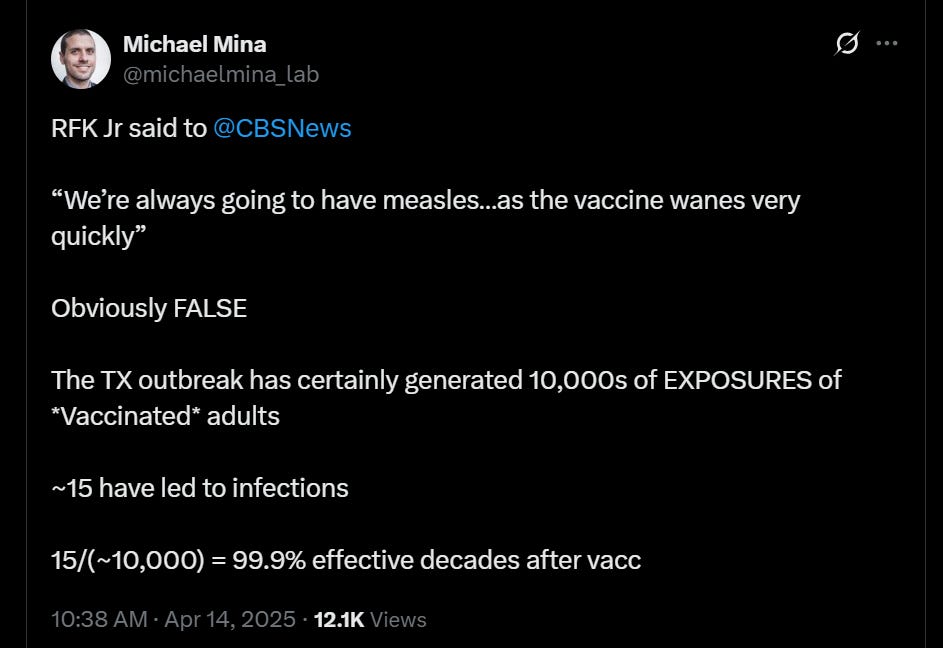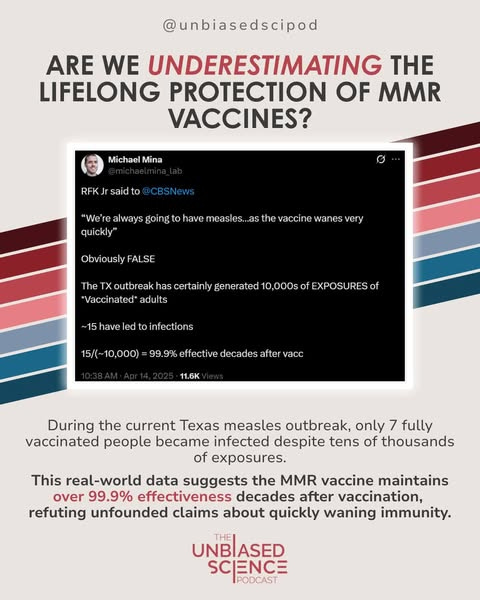MMR Vaccine Effectiveness: Decades Later, Still Protected
The Math Reveals Even Greater Protection Than We Thought
Recently, I came across a thought-provoking tweet from Dr. Michael Mina about the ongoing measles outbreak in Texas. He pointed out something remarkable: during this outbreak, only a small number of fully vaccinated individuals became infected despite what appeared to be tens of thousands of potential exposures. Dr. Mina's calculation suggested an effectiveness rate of approximately 99.9% decades after vaccination—a figure that challenges conventional understanding of vaccine durability.
This observation got me thinking: Could we be underestimating the long-term protection provided by the MMR vaccine? Let's discuss...
The Texas Measles Outbreak: What We Know
As of April 18, 2025, Texas has confirmed 597 measles cases since January, with 62 hospitalizations and 2 deaths—both in unvaccinated children with no underlying medical conditions. This outbreak, centered in West Texas communities with low vaccination rates, represents the largest measles resurgence in Texas in nearly 30 years.
The Texas Department of State Health Services has identified ten counties with ongoing measles transmission: Cochran, Dallam, Dawson, Gaines, Garza, Lynn, Lamar, Lubbock, Terry, and Yoakum. Gaines County remains the epicenter with 371 cases, representing 62.1% of the total outbreak.
What Makes Measles So Challenging
Understanding measles' extraordinary contagiousness helps explain why vaccination is so critical:
Extremely contagious: Measles has an R₀ of 12-18 in susceptible populations, meaning each infected person can potentially infect 12-18 others. The R₀ (basic reproduction number) is a measure used in epidemiology to indicate how contagious an infectious disease is.
Airborne longevity: The virus can remain viable in the air for up to 2 hours after an infected person leaves an area.
High attack rate: Without vaccination, approximately 90% of susceptible people exposed to measles will become infected.
Note that the infographic was created earlier this week and uses slightly different case numbers (561) than this newsletter, which contains the most up-to-date figures (597) as of April 18, 2025.
A Note on Our Calculations
Our calculations of vaccine effectiveness are based on early estimates from the outbreak. After consulting with experts, I should note some important nuances about calculating vaccine effectiveness from outbreak data:
Estimating exposures is complex: The R₀ of 12-18 for measles applies to fully susceptible populations. Using this value directly to calculate exposures in a partially vaccinated population likely overestimates the number of vaccinated people exposed.
Clustered transmission patterns: Measles outbreaks often remain concentrated in under-vaccinated communities with specific social interaction patterns. This clustering means exposure isn't evenly distributed across the general population.
Symptomatic transmission: Unlike COVID-19, people with measles are typically symptomatic when contagious, which changes mobility and exposure patterns.
While these factors suggest our 99.9% effectiveness calculation may be an overestimate, the broader observation remains valid: the number of breakthrough infections (when a person gets infected even though they have been vaccinated) is remarkably low given the outbreak's size, indicating strong long-term protection from MMR vaccination.
Vaccination Gaps and Their Consequences
The outbreak's epicenter, Gaines County, had a kindergarten MMR vaccination rate of only 82%—well below the 95% threshold needed for effective community protection. Some local school districts reported even lower rates, with one public school district at just 46% and a private school in North Texas at 14.3%.
These gaps created ideal conditions for the virus to spread rapidly among unvaccinated individuals, who constitute the vast majority of cases in this outbreak.
Reconsidering Vaccine Effectiveness Calculations
While our calculations present estimates based on early data, estimating true vaccine effectiveness from outbreak data requires careful consideration of several factors:
Challenges in Exposure Estimation
Selective mixing patterns: Unvaccinated communities often have distinct social networks, meaning vaccinated and unvaccinated populations don't mix randomly.
Effective reproduction number: The actual transmission rate in a partially vaccinated population is significantly lower than the basic R₀.
Geographic concentration: Exposure risk varies dramatically between outbreak epicenters and surrounding areas.
A More Conservative Approach
Rather than claiming a specific effectiveness percentage, we can make several observations:
Very few breakthrough cases: The number of breakthrough cases represents only a tiny fraction of total cases, despite the outbreak's size and duration.
Strong relative protection: Unvaccinated individuals appear to be approximately 80 times more likely to become infected than vaccinated people.
Durable immunity: The fact that so few vaccinated people became infected, even among those vaccinated decades ago, strongly contradicts claims that MMR protection "wanes very quickly."
Comparison to Established Literature
The established literature on MMR vaccine effectiveness typically reports:
Clinical trials and controlled studies: Effectiveness of approximately 97% with two doses.
Cochrane Reviews: Systematic reviews confirm high effectiveness but typically report slightly lower figures than our outbreak-based calculations (which suggest effectiveness of 99.9%).
Breakthrough studies: Previous outbreak investigations have documented small numbers of breakthrough cases, consistent with what we're seeing in Texas. For individuals who received 2 doses of the MMR vaccine, breakthrough rates have been shown to be approximately 5% in previous studies.
The apparent discrepancy between the established literature (97% effectiveness) and our calculations from the Texas outbreak (99.9% effectiveness) may reflect several factors:
Study methodologies: Controlled studies often use different methods than real-world outbreak analyses. For example, some studies measure antibody response in laboratory settings rather than tracking actual infection rates during outbreaks.
Exposure intensity: Laboratory-confirmed immunity may differ from protection against intense real-world exposure. The controlled environments of studies may not fully represent the variable exposures during an actual outbreak.
Population differences: The populations studied in clinical trials may differ from those involved in the current outbreak in terms of age, time since vaccination, and other factors that could influence immunity.
The Immunology Behind Long-lasting Protection
What explains the remarkable durability of MMR-induced immunity? Current immunological understanding suggests several mechanisms:
Memory B cells: Even when antibody levels decline, memory B cells persist and can rapidly produce new antibodies upon re-exposure to their specific pathogen. Memory B cells exist to provide long-lasting protection. They continually 'patrol' the body looking for their specific pathogen, but produce very little to no antibody.
T cell-mediated immunity: Cellular immunity provides protection even when antibody levels have waned. Cellular immunity refers to the immune response generated by T cells, specifically cytotoxic or 'killer' T cells. Cytotoxic T cells target and kill infected cells.
Germinal center responses: A germinal center is an area inside certain body parts (such as lymph nodes or spleen) where B cells gather during an active immune response, when a person has an infection or has received a vaccine. In the germinal center, B cells multiply and get better at making specific antibodies for a given infection. This process helps to induce very strong and long-lasting immune responses to vaccines like the MMR.
This multi-layered protection helps explain why MMR immunity remains strong decades after vaccination, even if measurable antibody levels decline over time.
Public Health Implications
Whether the actual effectiveness is 97% or closer to 99%, several implications are clear:
Lifelong protection: The two-dose MMR series provides robust protection that likely lasts throughout life for most individuals.
Herd immunity thresholds: Maintaining high vaccination rates (≥95%) remains critical for preventing outbreaks.
Value of completion: Ensuring children receive both recommended doses provides substantial long-term benefit.
Countering misinformation: Claims about rapidly waning MMR protection are directly contradicted by real-world evidence.
Conclusion: What This Means for Public Health
Dr. Mina's observation about the Texas outbreak has helped highlight something important: the MMR vaccine likely provides even stronger and more durable protection than commonly discussed. Whether the exact effectiveness figure is 97% or 99.9% matters less than the clear evidence that protection remains robust decades after vaccination.
For individuals who received their MMR vaccines in childhood, this should provide reassurance that their protection likely remains strong. For parents considering vaccination for their children, this data underscores the long-term value of completing the recommended two-dose series.
The bottom line is clear: MMR vaccines don't "wane quickly." They provide remarkable, long-lasting protection against one of the most contagious diseases known to humanity.
Stay Curious,
Unbiased Science
P.S. Want to support this kind of analysis? The best way is to subscribe to our Substack and share our work. While all our articles are always completely free to read, paid subscriptions help sustain our in-depth reporting on vaccine policy and public health. Thank you for considering it!
Special thanks to Dr. Michael Mina for highlighting this real-world effectiveness data and to the Texas Department of State Health Services for their continued updates on this outbreak.
References
Amanna, I.J., Carlson, N.E., & Slifka, M.K. (2007). Duration of humoral immunity to common viral and vaccine antigens. New England Journal of Medicine, 357(19), 1903-1915.
Breakwell, L., Moturi, E., & Helgenberger, L. (2015). Measles outbreak associated with vaccine failure in adults—Federated States of Micronesia, February--August 2014. MMWR, 64(38), 1088-1092.
Guerra, F.M., Bolotin, S., Lim, G., et al. (2017). The basic reproduction number (R₀) of measles: a systematic review. The Lancet Infectious Diseases, 17(12), e420-e428.
LeBaron, C.W., Beeler, J., Sullivan, B.J., et al. (2007). Persistence of measles antibodies after 2 doses of measles vaccine in a postelimination environment. Archives of Pediatrics & Adolescent Medicine, 161(3), 294-301.
Robert, A., Suffel, A. M., & Kucharski, A. J. (2024). Long-term waning of vaccine-induced immunity to measles in England: A mathematical modelling study. The Lancet Public Health, 9(10).
Texas Department of State Health Services. (2025, April 18). Measles Outbreak – April 18, 2025. https://www.dshs.texas.gov/news-alerts/measles-outbreak-2025
World Health Organization. (2023). Measles. https://www.who.int/news-room/fact-sheets/detail/measles
National Foundation for Infectious Diseases. (2024). Measles. https://www.nfid.org/infectious-disease/measles/
Centers for Disease Control and Prevention. (2023). Measles Questions and Answers. https://www.cdc.gov/measles/about/questions.html
Johns Hopkins Bloomberg School of Public Health. (2025). Measles Risk Assessment. https://publichealth.jhu.edu/sites/default/files/2025-02/Measles-Risk-Assessment-2.13.25.pdf
Cochrane Library. (2022). Vaccines for measles, mumps, rubella in children. https://www.cochranelibrary.com/cdsr/doi/10.1002/14651858.CD004407.pub5/full
Infectious Diseases Society of America. (2024). Measles: Know the Facts. https://www.idsociety.org/public-health/measles/know-the-facts/









Jess: Thank you for the excellent overview of the measles epidemic and vaccine effectiveness.
After assuming the role as Sec. of HHS, RFK Jr. has consistently suggested that the benefits of the MMR vaccine "wanes at 4.5% per year." Mr. Hannity, for example, didn't think to ask him from where he derived this calculation, undoubtedly believing (like most of us) that it was from "thin air." If this were, indeed, the case, we could have reasonably expected a significant number of cases among those vaccinated prior to 1980, particularly in those who only received a single dose. Likewise, in states & areas with falling rates of overall vaccination and the protective, resultant herd immunity, it would seem to only compound the problem. Nevertheless, an epidemic has yet to develop in that specific cohort. Could it be related to an increased consumption of Vitamin A, inhaled corticosteroids, and Z-Packs, or is Mr. Kennedy sadly mistaken? I think you have the bases covered...